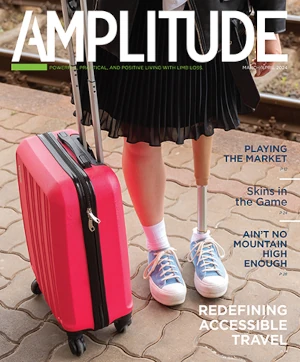
Clancy tests the hand-wrist prosthesis. Photograph courtesy of Worcester Polytechnic Institute.
A research team at Worcester Polytechnic Institute (WPI) is working to provide more functional, convenient, and robust hand-wrist prosthetic options by using electrical impulses generated by residual muscles in the forearm to enable two degrees of freedom. The researchers said their goal is for hand-wrist prostheses to more closely duplicate the natural synchronized action of the human hand and wrist.
In part, the research is aimed at providing better prosthetics options for returning soldiers with transradial amputations who have found it either difficult or impossible to perform a wide range of daily tasks with current one-degree-of-freedom hand-wrist prostheses. The research is being funded by a two-year subaward of $712,812 from Liberating Technologies, Holliston, Massachusetts. The National Institutes of Health gave LTI a $1.4 million grant to help solve these problems.
The work is currently focused on how to translate signals picked up from muscle activity in the forearm into appropriate movements of the hand-wrist prosthesis. The team began by collecting data from 64 or more electrodes, but recognizing that a device with that many inputs could be burdensome or impractical, they are attempting to achieve the same effect with as few as four electrodes.
“We want to be able to control two degrees of freedom while making instrumentation that is really tiny and easy to apply,” said Edward Clancy, PhD, co-principal investigator and professor of electrical and computer engineering at WPI.
The researchers are also developing new algorithms and methods to help select the optimal locations for the four electrodes. Those algorithms will be embedded into a microprocessor within a prototype prosthesis. The next step will be to develop a more convenient and robust multielectrode clinical prosthesis fitting system that will determine the optimal electrode locations and convert muscle activity into the movement of motors in the prosthetic hand and wrist components. The team will also connect the electrodes wirelessly using embedded, low-power integrated circuits and rechargeable batteries.
Editor’s note: This story was adapted from materials provided by WPI.



